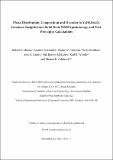Phase distribution, composition and disorder in Y2(Hf,Sn)2O7 ceramics : insights from solid-state NMR spectroscopy and first-principles calculations
Abstract
A NMR crystallographic approach, combining 89Y, 119Sn and 17O NMR spectroscopy with X-ray diffraction and first-principles calculations has been used investigate the number and type of phases present, and the local structure and disorder in Y2Hf2–xSnxO7 ceramics. Although a phase change is predicted with increasing Hf content, NMR spectra clearly show the presence of a significant two-phase region, with a Sn-rich pyrochlore and relatively Hf-rich defect fluorite phase co-existing for much of the compositional series. A single-phase pyrochlore is found only for the Sn end member, and a single defect fluorite phase only for x = 0 to 0.2. A solid-solution limit of ~10% is seen for the substitution of Hf into Y2Sn2O7, although no evidence is seen for any cation ordering or antisite disorder in this phase. In the defect fluorite phase there is preferential ordering of oxygen vacancies around Sn, which is only ever seen in a six-coordinate environment. The remaining vacancies are more likely to be associated with Hf than with Y, although this distinction is less apparent at higher Sn concentrations. To acquire 17O NMR spectra samples were post-synthetically exchanged with 17O2(g), although high temperatures (> 900 ºC) were required to ensure uniform enrichment of different chemical species. although these 17O NMR spectra confirm the formation of mixed-metal materials and the presence of two phases, more quantitative analysis is hindered by the overlap of signals from pyrochlore and defect fluorite phases. In all cases, DFT calculations play a vital role in the interpretation and assignment of the NMR spectra, and in understanding the local structure and disorder in these complex multi-phase materials.
Citation
Moran , R F , Fernandes , A , Dawson , D M , Sneddon , S , Gandy , A S , Reeves-McLaren , N , Whittle , K R & Ashbrook , S E 2020 , ' Phase distribution, composition and disorder in Y 2 (Hf,Sn) 2 O 7 ceramics : insights from solid-state NMR spectroscopy and first-principles calculations ' , Journal of Physical Chemistry C , vol. 124 , no. 31 , pp. 17073–17084 . https://doi.org/10.1021/acs.jpcc.0c04542
Publication
Journal of Physical Chemistry C
Status
Peer reviewed
ISSN
1932-7447Type
Journal article
Description
The authors would like to thank the ERC (EU FP7 Consolidator Grant 614290 “‘EXONMR’”), and EPSRC for support for SS and ASG (EP/L005581/1). SEA would like to thank the Royal Society and Wolfson Foundation for a merit award. We acknowledge support from the Collaborative Computational Project on NMR Crystallography CCP-NC funded by EPSRC (EP/M022501/1).Collections
Items in the St Andrews Research Repository are protected by copyright, with all rights reserved, unless otherwise indicated.

